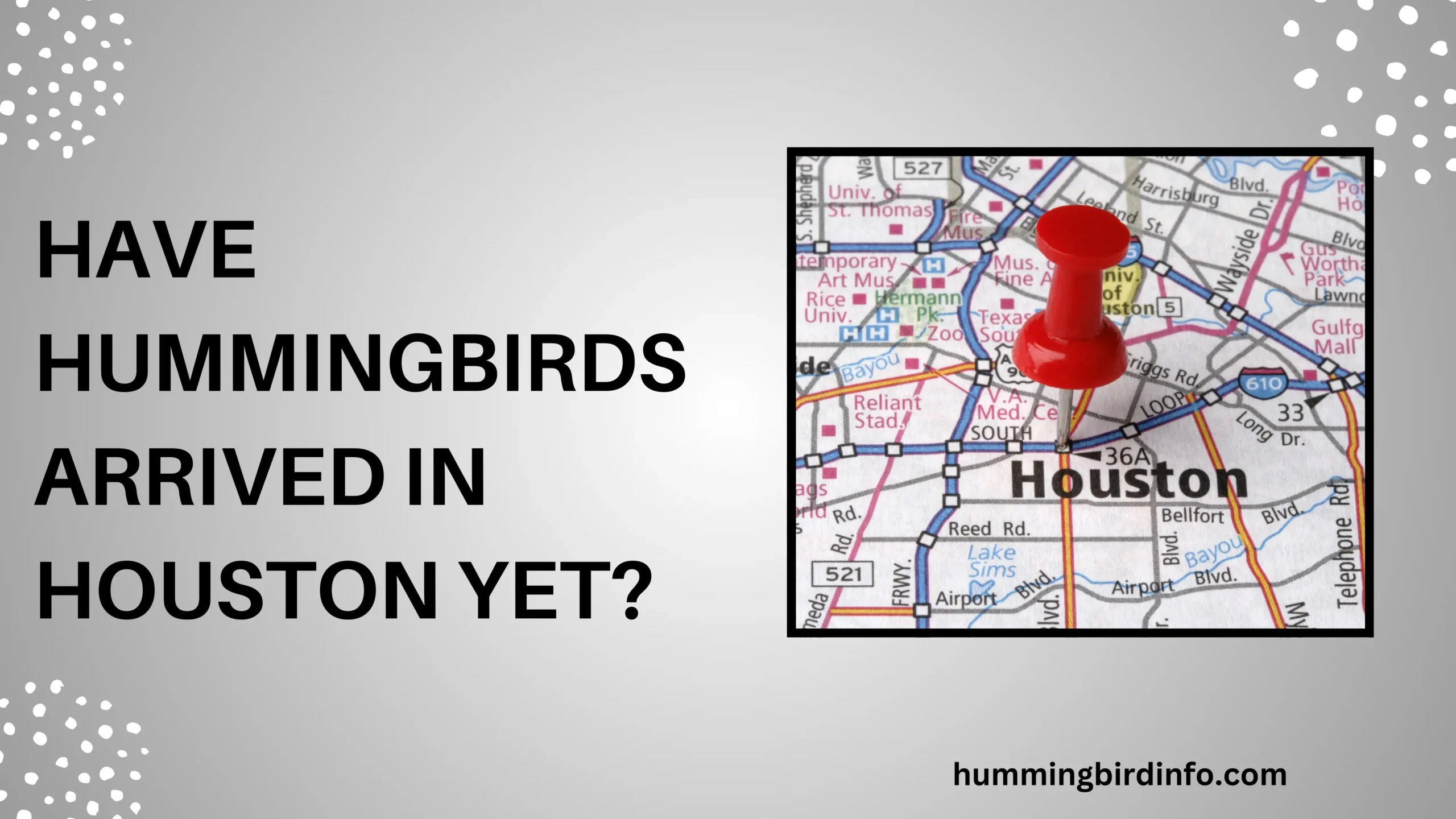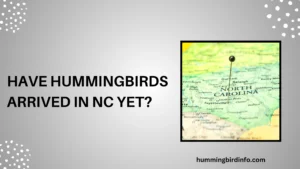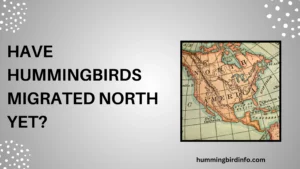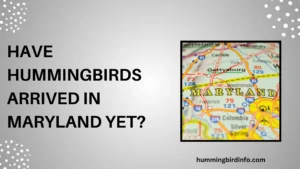The arrival of hummingbirds is one of the most delightful signs that spring has reached Houston. These tiny birds, with their glittering feathers and incredible flight skills, captivate anyone lucky enough to spot them.
Their wings hum as they hover mid-air, darting from flower to flower, bringing life and movement to quiet gardens.
Houston isn’t just a city of skyscrapers—it’s also a key stop on the migration path of hummingbirds. Every year, birdwatchers and gardeners across the area eagerly await their return, checking feeders and flowerbeds for the first flash of a ruby throat.
Whether you’re a backyard hobbyist or a seasoned bird enthusiast, their arrival is something worth looking forward to.
In this guide, we’ll explore when hummingbirds arrive in Houston, which species you might see, and what influences their migration. You’ll also learn where to go to observe them and how to make your yard a hummingbird haven.
If you’re wondering whether it’s time to put out your feeders, you’re in the right place.
Contents
- 1 Timing the Arrival – Hummingbird Migration in Houston
- 2 Hummingbird Species of Houston
- 3 Factors Influencing Hummingbird Migration in Houston
- 4 Where to See Hummingbirds in Houston
- 5 Attracting Hummingbirds to Your Yard
- 6 Conclusion
- 7 FAQ’s
- 8 1. When do hummingbirds arrive in Houston in spring?
- 9 2. Can I see hummingbirds in Houston during the winter?
- 10 3. What is the best time to put out hummingbird feeders in Houston?
- 11 4. What kind of nectar should I use in my feeder?
- 12 5. What plants attract hummingbirds in Houston?
- 13 6. Where are the best places to see hummingbirds in Houston?
Timing the Arrival – Hummingbird Migration in Houston
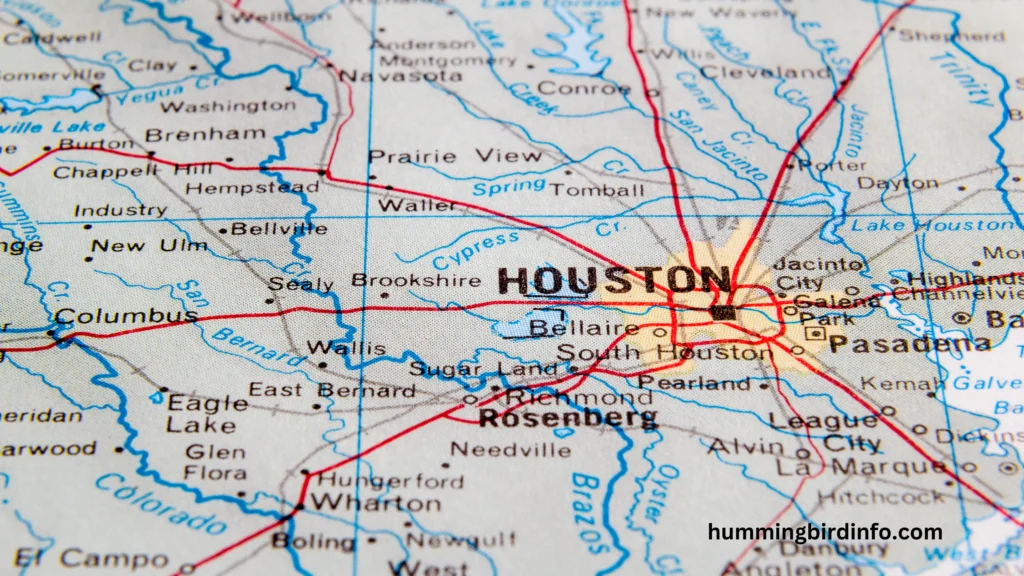
Spring migration in Houston usually starts in early March and lasts through May. During this time, Ruby-throated hummingbirds begin arriving, with males typically leading the way to establish territories.
The females follow shortly after, often by mid to late March.
Fall migration starts around August and can extend into October, with peak activity seen in September. Unlike spring, fall brings larger numbers as young birds from the summer season join the journey south. It’s the perfect season to spot these tiny travelers.
Although migration brings the highest numbers, a few hummingbirds stay in Houston year-round. Species like the Black-chinned and Rufous hummingbirds have been reported in the winter.
Houston’s location makes it a vital rest stop for hummingbirds crossing the Gulf of Mexico, so timing can shift with weather and climate conditions.
Hummingbird Species of Houston
The Ruby-throated hummingbird is the most commonly seen species in Houston during migration. The males are known for their striking red throats, while females have a pale, greenish plumage.
They breed in the eastern U.S. and travel thousands of miles between Central America and the U.S..
Another visitor is the Black-chinned hummingbird, often spotted in winter months. These birds have a darker throat that can appear purple in sunlight. They are more commonly found in western Texas but do pass through Houston occasionally.
Rufous hummingbirds are feisty and known for their long migrations—some travel all the way from Alaska to Mexico. Other rare visitors to Houston include Anna’s, Allen’s, and Broad-tailed hummingbirds, though sightings are less common.
The Houston Audubon Society provides excellent guides and regular updates on local hummingbird activity, helping bird lovers identify and enjoy these special guests.
Factors Influencing Hummingbird Migration in Houston
Daylight changes, or photoperiod, signal hummingbirds to begin their journey. As the days grow longer in spring, birds know it’s time to head north. The opposite is true in fall, prompting their return south.
Food availability plays a major role. Flowering plants and insects provide the energy these birds need for migration. Plants native to Texas bloom right when hummingbirds pass through, making Houston ideal for a feeding stop.
Weather patterns can speed up or slow down migration. A warm front may bring early arrivals, while a cold snap can cause delays. Since many hummingbirds fly over the Gulf, storms or strong winds can make their journey dangerous, causing some to stop in Houston for safety and rest.
Habitat also matters. Birds look for places with nectar, insects, water, and shelter. Houston’s mix of urban gardens, parks, and green spaces provides vital resources during both spring and fall migration.
Where to See Hummingbirds in Houston
Houston offers some amazing hummingbird-watching spots, both in the city and in nearby natural areas. The Houston Arboretum & Nature Center is a local favorite, featuring trails and native plants that attract many bird species.
At the Edith L. Moore Nature Sanctuary, you can walk through wooded areas known for high bird activity. Buffalo Bayou Park and Brazos Bend State Park are also great for seeing migrating hummingbirds in action.
You don’t even need to leave your house—your own garden can become a mini bird sanctuary. By planting the right flowers and adding feeders, you can draw hummingbirds right to your windows and patios.
To stay updated, check eBird for real-time hummingbird sightings. Local birders report where and when birds are seen. You can also share your own sightings to help track migration patterns across Houston.

Attracting Hummingbirds to Your Yard
To attract hummingbirds, start by planting native Texas plants that bloom during migration. Excellent choices include Turk’s cap, Salvia greggii, coral honeysuckle, and firebush. These plants offer natural nectar and thrive in Houston’s climate.
Adding a hummingbird feeder can increase your chances of attracting these birds. Use a four-parts water to one-part white sugar mixture—no red dye needed. Clean the feeder every few days to prevent mold or harmful bacteria.
Place feeders near flowering plants or trees, ideally in shady spots. Consider setting them out in early March to welcome spring arrivals and again in August for fall migration. Leave feeders up until late October to help late travelers.
Provide a source of clean water, such as a birdbath with a mister or dripper. Hummingbirds also benefit from tree cover, which gives them a safe space to rest. Avoid using pesticides, as these can poison both birds and the insects they eat.
Conclusion
Hummingbirds have likely arrived—or are about to arrive—in Houston, depending on the time of year. In spring, expect them from March to May, and in fall, from August through October. Their journey is long and full of challenges, but Houston is a vital part of their success.
These birds are not only fascinating to watch, but also play a key role in pollination and maintaining ecological balance. With a little effort, you can support their journey and enjoy their presence in your own backyard.
Now’s the perfect time to prepare your feeders, plant some native flowers, and keep your eyes open. The buzz of tiny wings could be just outside your window, a gentle reminder of the natural wonder we share in Houston.
FAQ’s
1. When do hummingbirds arrive in Houston in spring?
Most Ruby-throated hummingbirds arrive between March and May, with males appearing slightly earlier than females.
2. Can I see hummingbirds in Houston during the winter?
Yes, though in smaller numbers, species like the Black-chinned and Rufous hummingbirds may be spotted during winter months.
3. What is the best time to put out hummingbird feeders in Houston?
Set out feeders in early March for spring and again in August for fall migration. Keep them out until late October.
4. What kind of nectar should I use in my feeder?
Use a mix of 1 part sugar to 4 parts water. Avoid red dye, as it can be harmful to birds.
5. What plants attract hummingbirds in Houston?
Great options include Turk’s cap, salvia, firebush, and coral honeysuckle—all rich in nectar and suited to the climate.
6. Where are the best places to see hummingbirds in Houston?
Top spots include the Houston Arboretum, Buffalo Bayou Park, and Edith L. Moore Sanctuary.

